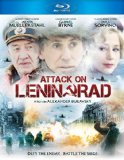This historical film looks at the three-year siege of Leningrad during World War 2. The film follows a Russian, female police officer who aids a stranded, English news reporter as they try to survive the siege. Said survival goes beyond enduring the battles between Russian and German forces as a lot of focus is placed on the starvation of the denizens of Leningrad as supplies become desperately limited and the people must live off of 300 grams of rations a day, an amount that declines as days go by.
There is a nice balance between depictions of those fighting the battles and civilians just trying to survive. The battles themselves are accurately brutal at times, and the city of Leningrad is looks as cold and wreaked with famine as its inhabitants. Visually, this film does a wonderful job of recreating the horrible images of war. There are dead bodies frozen on the streets and battlefields that the characters have to become acclimatized to.
The English reporter is of Russian heritage which helps to make the ‘fish-out-of-water’ angle less pertinent as she bonds with the Russian policewoman. Having an outsider’s perspective merging via this friendship, with someone involved in the military actions of the Russian armies the events in Leningrad aids the exposition as we are taken as both women start from observing most of the suffering to being overwhelmed by despair and having to suffer on equal terms with the rest of Leningrad. Black market dealers become literal meat markets as tinned goods and horse meat become luxury items worthy of trading jewelery and other treasures for.
The film resembles an apocalyptic survivalist film (normally set in the distant future) at many points, and for many it was the end of all things as over a million Red Army soldiers died over the course of the siege, along with approximately 642,000 civilians. Such horrors are displayed without need of exaggeration in this film. There are also depictions of reporters and military commanders on both the Allied and Axis sides, but they are less memorable and only serve to emphasis both the boggling statistics attributed to Leningrad’s people (such as their ration diets and death counts) as well as the sorrow reaching outside the borders of the city the German force’s failed to conquer, but surely helped to nearly decimate completely.
Video
Widescreen 2.35:1. The action sequences are frequently exterior winter shots that exist almost entirely in shades rather than colours. The contrasts between black, white and gray is sharp enough when layered against each other. Beyond that, any interior or brightly lit close up shots shows a noticeable amount of haze; much more than should be expected from a Blu Ray release. A bit disappointing.
Audio
English track in Dolby Digital 2.0 and and English/Russian/German (original) track in Dolby Digital 5.1 Surround. Both track options have quiet dialogue that is not really balanced with the explosions of the battle scenes and means that some volume adjusting has to be made as the action ebbs and flows.
Special Features
Interview with Director Alexander Buravsky: An English interview where the director conveys his earnest passion for depicting these horrific events and sternly remarks how he feels this may be one of the greatest tragedies in the 20th century. Said passion certainly reflected in this film.
Heroes Under Siege: The Making Of Featurette: A lengthy and quite in depth look at the production and shooting. Well assembled and maintained my interest throughout. The cast and crew of this film were talented people indeed.
Final Thoughts
This film is thorough in its story telling and feels a bit longer than it is. It has the look of a lengthy war epic but only clocks in at 110 minutes. The pacing could have been a bit better and the screenplay gets a bit clunky when trying to decide how to move things to the next big event. Even so, History buffs will already know the significance of Leningrad, but will hopefully appreciate this film’s reiteration anyways.




